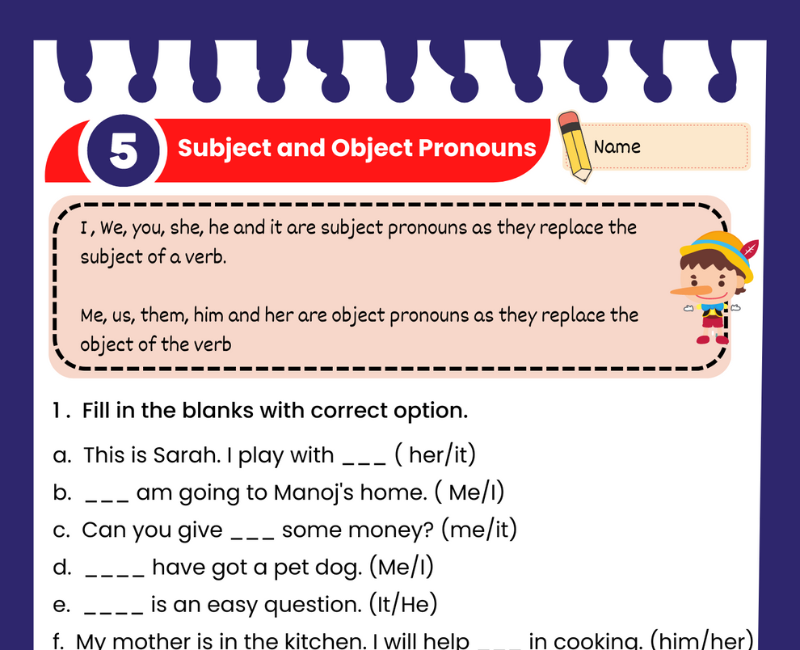Subject and Object Pronouns Worksheet For Class 2
It's important to understand the difference between subject and object pronouns in English. This worksheet will provide a review of the basics and help you strengthen your grammar skills as you practice using subject and object pronouns correctly
What are Subject and object pronouns
Subject and object pronouns are two types of pronouns that are used in English grammar to replace nouns in sentences. They help make sentences more concise, less repetitive, and easier to understand.
Subject pronouns are used to replace the subject of a sentence, which is the person or thing performing the action. The subject pronouns are:
- I
- You
- He
- She
- It
- We
- They
For example, instead of saying "John is reading a book," you can use the subject pronoun "he" to replace "John" and say, "He is reading a book."
Object pronouns, on the other hand, replace the object of a sentence, which is the person or thing receiving the action. The object pronouns are:
- Me
- You
- Him
- Her
- It
- Us
- Them
For example, instead of saying "Sara gave the book to Maria," you can use the object pronoun "her" to replace "Maria" and say, "Sara gave the book to her."
It is important to understand the difference between subject and object pronouns and use them correctly in sentences to maintain proper grammar and enhance language fluency
Identify Subject and Object Pronouns in Sentences.
I , We, you, she, he and it are subject pronouns as they replace the subject of a verb.
Me, us, them, him and her are object pronouns as they replace the object of the verb
When it comes to mastering the English language, understanding the usage of subject and object pronouns is essential. This is where subject and object pronouns worksheets come in handy, as they provide an interactive and engaging way for learners to practice their skills. By using a subject and object pronouns worksheet, students can easily familiarize themselves with the various pronoun subject and object forms and their appropriate usage in sentences.
So, what are the object pronouns and subject pronouns? In simple terms, subject pronouns replace the subject in a sentence, while object pronouns replace the object. Some common examples of subject and object pronouns include "I," "you," "he," "she," "it," "we," "they" (subject pronouns), and "me," "you," "him," "her," "it," "us," "them" (object pronouns). Understanding the difference between these two types of pronouns is crucial for constructing grammatically correct sentences.
A subject and object pronoun worksheet typically contains a variety of exercises designed to help learners recognize and use these pronouns correctly. For instance, a worksheet on subject and object pronouns might include fill-in-the-blank sentences, multiple-choice questions, and sentence transformation tasks. These exercises challenge learners to identify whether a pronoun should be used as a subject or object pronoun, thus reinforcing their understanding of the topic.
Subject and object pronouns worksheets come in various formats, catering to the needs of different learners. Some may prefer a more visual approach, with subject and object pronoun examples presented in tables or charts. Others may opt for a more traditional worksheet format, where they can practice subject and object pronouns exercises through written tasks.
For educators and learners looking for a comprehensive resource, subject and object pronouns worksheets with answers PDF files are an excellent choice. These documents not only contain a variety of exercises but also provide detailed answer keys, making them a valuable self-study tool. By working through object and subject pronouns exercises and reviewing the answers, learners can quickly identify any areas where they need further practice.
Subject and object pronouns exercises with answers are also available in online formats, allowing learners to practice their skills on a computer or tablet. These digital resources often include interactive features, such as drag-and-drop activities and quizzes, which can make learning more engaging and enjoyable. Whether you prefer a traditional subject pronouns and object pronouns worksheet or a digital resource, the key is to practice regularly to build a solid understanding of this fundamental grammar concept.
Subject and object worksheets with answers cater to various skill levels, from beginner to advanced. For those just starting out, a basic subject or object pronoun worksheet may focus on identifying and using the most common pronouns in simple sentences. As learners progress, more advanced subject and object pronouns exercises with answers can be introduced, challenging them to apply their knowledge in more complex sentences and contexts.
In addition to standalone subject and object pronouns worksheet with answers, many comprehensive English grammar textbooks and online resources also cover this topic. These materials often include a detailed explanation of what are subject pronouns and object pronouns, along with examples and exercises to reinforce learning. By using a combination of subject to object pronouns worksheets, explanations, and exercises, learners can build a strong foundation in this essential area of English grammar.
Subject and object pronouns sentences are a great way for learners to see these pronouns in action. By analyzing real-life examples and practicing with exercises, students can develop a better understanding of what is subject and object pronouns and how they function in the English language. Subjective, objective, and possessive pronouns worksheet with answers can further enhance this understanding by exposing learners to different types of pronouns and their correct usage.





